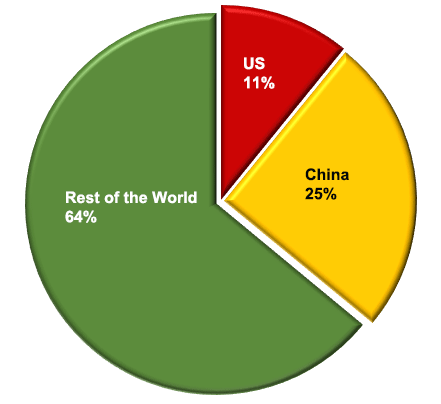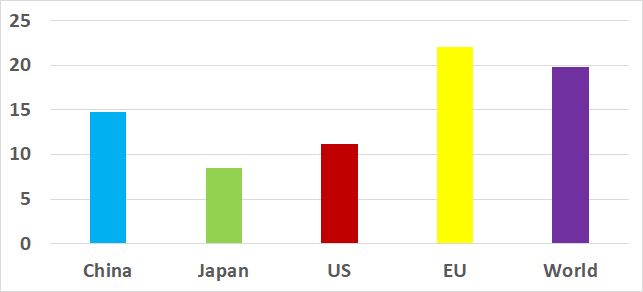Image courtesy of @ClimateEnvoy
The U.S. and China along with other countries are experiencing extreme weather (including scorching heat, floods and typhoons) exacerbated by global climate change. U.S. climate envoy John Kerry met with his Chinese counterpart Xǐe Zhènhuá 解振华 in Beijing this week. This was their first meeting since China ended such discussions in response to the visit Nancy Pelosi, then House speaker, made to Taiwan a year ago. China has been the biggest emitter of greenhouse gases since overtaking the U.S. in 2007. China is now responsible for about 25% of emissions and the U.S. about 11%. Of course, on a per capita basis Americans are responsible for much larger emissions. U.S. and European emissions were much greater for a century. As the leading emitters, what the U.S. and China do to slow climate change and mitigate its impact is critical for all. Both countries have adopted policies to reduce their dependence on fossil fuels and there has been some sharing of clean energy research. Both countries have greatly increased their commitment to and production of renewable energy.
The U.S. and China have less than a quarter of the world's population, but produce more than a third of global greenhouse gas emissions. This outsized role in contributing to the challenge of climate change can be seen in this chart showing their relative shares of 2021 emissions. The data is from the Global Carbon Project and the U.S. Environmental Protection Agency. In 2000, the U.S. produced 19% of the world's greenhouse gases and China produced 14%.

China acknowledges the need to reduce its emissions and has taken measures to do so, but it notes that the historic role of the U.S. and Europe in producing emissions that continue to contribute to the greenhouse effect is enormous. The chart below shows that the U.S. and Europe (not including Russia or Ukraine) had contributed 47% of all the greenhouse gases between 1750 and 2017. The chart is produced by Our World in Data utilizing data from the Global Carbon Project.

On a per capita basis, of course, the U.S. emits far more than China (or Europe and Japan). The USCI chart below draws on World Bank data. Chinese emissions per capita are rising while American emissions per capita are falling. But because the average American consumes so much more energy and produces more emissions than Chinese or others, China has continued to increase fossil fuel use and Xi Jinping said on July 18, 2023 that China plans to achieve carbon neutrality by 2050, “but the path, method, pace and intensity to achieve this goal should and must be determined by ourselves, and will never be influenced by others.”
The U.S. and China are investing huge sums in trying to increase the contribution renewable sources make to their countries energy production and consumption mix. Both are also seeking to increase energy efficiency. The USCI chart below draws on World Bank data for 2020. The renewable sources share in China's total energy consumption in 2020 was 14.8%. It was 11.2% for the U.S. Both lag overall figures for the world (19.8%) and the European Union (22.1%).

John Kerry has met several times with Xie Zhenhua, China's point person on climate change policy. Kerry will turn 80 and Xie 74 later this year. What they do matters not just for those of us alive today, but generations to come.
The Coexistence of Taiwanese and Mandarin in Taiwan

Image courtesy of Brookings
The Taiwanese language faces challenges in Taiwan, despite around 80% of the population speaking it to some extent. Mandarin remains the dominant language for official use and daily life. The Taiwanese language, belonging to the Southern Min group, competes with Hakka and Austronesian languages, all experiencing potential decline. Historical factors, such as Japanese rule and Mandarin-only policies, contribute to the language's precarious position. Recent efforts, including the "Bilingual 2030" policy, aim to promote English learning, raising concerns about Taiwanese language preservation. To learn more, check out this US-China Today article by Andrew Gallegos on the subject here.
Cracking the Barbie Movie Controversy

Image courtesy of Warner Bros
A impressionistic map appears in the new Barbie film coming out tomorrow. It includes a line similar to the one China uses to outline its territorial claims in the South China Sea. Vietnam won’t officially screen the film as a result, though the Philippines has said it will. USCI’s Clayton Dube discussed this with KCRW when Vietnam issued its ban. USCI’s short documentary on the contested region is here. USCI’s document collection includes a variety of reports and statements on the region.
2023 USC/CUC Global Exchange Workshop Film Premiere
Since 2006 USC and Communication University of China students have partnered each summer to produce short documentaries. You can see some of their films at our website and YouTube channel. But if you can, you’ll want to be in the audience on Friday evening, July 21 at USC’s School of Cinematic Arts where students led by Professors Pablo Frasconi and Han Ying will screen the films they’ve created this summer.
USC School of Cinematic Arts
SCA 112 (D-3 on this map)
6-8 pm





